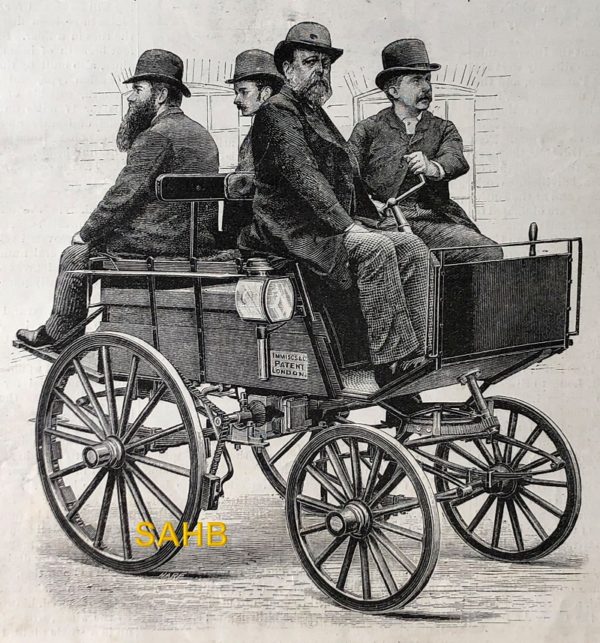
As electric traction takes over modern motoring it is sobering to think that this form of propulsion for road vehicles has been around since the dawn of powered transport. Our Snapshot shows the ‘Electric Carriage’ built by Immisch & Co. of London for the Sultan of Turkey. Its appearance was unsurprisingly that of a horseless carriage – in fact the report in Scientific American and The Engineer showed some disappointment with the design: “In appearance the vehicle does not differ from an ordinary four-wheeled dog cart with the shafts removed, and in this respect the design is perhaps open to criticism, as something might have been done to take off the uncompromising squareness presented by the splash board, and so give the appearance of a carriage specially adapted for this new mode of propulsion.” Thus, even in these very early days, writers were hoping for the modernity of appearance to match the innovation of a self-propelled vehicle.
The carriage was powered by an Immisch one-horsepower motor placed in the centre of the body of the vehicle. It was said to run at a current of 20 amperes and an ‘electromotive force’ of 48 volts. This equates to 960 watts or 1.29 horsepower – so the manufacturer’s claimed power rating seems fair. Drive to the offside rear wheel was taken from a small pinion on the main shaft of the motor, visible in this picture, through a Renold chain that passed over L-shaped plates attached at intervals around the inner face of the wheel, effectively constituting a drive pulley. There were 24 small accumulators under the seats. Speed was claimed to be 10mph for about 5 hours.
Moritz Immisch (1838-1903) was an electrical engineer, watchmaker and inventor, born in Niederschmon in Germany. His father was a watchmaker, and it was in this field that he first sought his fortune after a technical education in Germany and emigration around 1860 to England with a younger brother, also a watchmaker. After some impressive horological work, Immisch in 1881 obtained a patent for a remarkably small and accurate watch-shaped metallic (rather than liquid) thermometer that became very popular in medical circles.
Immisch’s most significant work was with early applications of electric motors. By 1880, his experiments led him away from watchmaking and in 1882 he patented ‘an improved electro-motor’ and, with a small number of friends and colleagues, he established a small company ‘Messrs M. Immisch & Co.’ with works in Kentish Town. The company sought new industrial applications for their products, including pumping and haulage work in mines.
Immisch also built some of the first electric carriages from 1887 to 1896, and probably the world’s first fleet of electric boats for hire, with electrical charging stations established along the River Thames. His interests also extended to electric motors for tramcars, Sadly, having suffered from heart problems for several years, he died in 1903.
Image courtesy of The Richard Roberts Archive: www.richardrobertsarchive.org.uk







Leave a Comment